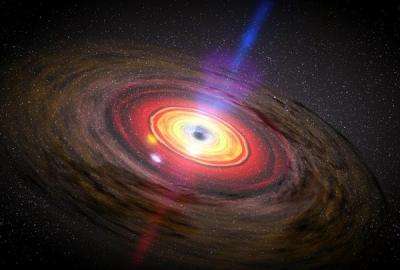Message in a wobble: Black holes send memos in light

Imagine a spinning black hole so colossal and so powerful that it kicks photons, the basic units of light, and sends them careening thousands of light years through space. Some of the photons make it to Earth. Scientists are announcing in the journal Nature Physics today that those well-traveled photons still carry the signature of that colossal jolt, as a distortion in the way they move. The disruption is like a long-distance missive from the black hole itself, containing information about its size and the speed of its spin.
The researchers say the jostled photons are key to unraveling the theory that predicts black holes in the first place.
“It is rare in general-relativity research that a new phenomenon is discovered that allows us to test the theory further,” says Martin Bojowald, a Penn State physics professor and author of a News & Views article that accompanies the study.
Black holes are so gravitationally powerful that they distort nearby matter and even space and time. Called framedragging, the phenomenon can be detected by sensitive gyroscopes on satellites, Bojowald notes.
Lead study author Fabrizio Tamburini, an astronomer at the University of Padova (Padua) in Italy, and his colleagues have calculated that rotating spacetime can impart to light an intrinsic form of orbital angular momentum distinct from its spin. The authors suggest visualizing this as non-planar wavefronts of this twisted light like a cylindrical spiral staircase, centered around the light beam.
“The intensity pattern of twisted light transverse to the beam shows a dark spot in the middle — where no one would walk on the staircase — surrounded by concentric circles,” they write. “The twisting of a pure [orbital angular momentum] mode can be seen in interference patterns.” They say researchers need between 10,000 and 100,000 photons to piece a black hole’s story together.
And telescopes need some kind of 3D (or holographic) vision in order to see the corkscrews in the light waves they receive, Bojowald said: “If a telescope can zoom in sufficiently closely, one can be sure that all 10,000-100,000 photons come from the accretion disk rather than from other stars farther away. So the magnification of the telescope will be a crucial factor.”
He believes, based on a rough calculation, that “a star like the sun as far away as the center of the Milky Way would have to be observed for less than a year. So it is not going to be a direct image, but one would not have to wait very long.”
Study co-author Bo Thidé, a professor and program director at the Swedish Institute of Space Physics, said a year may be conservative, even in the case of a small rotation and a need for up to 100,000 photons.
“But who knows,” he said. “We will know more after we have made further detailed modelling – and observations, of course. At this time we emphasize the discovery of a
new general relativity phenomenon that allows us to make observations, leaving precise quantitative predictions aside.”
More information: Nature Physics
Source: Universe Today


















